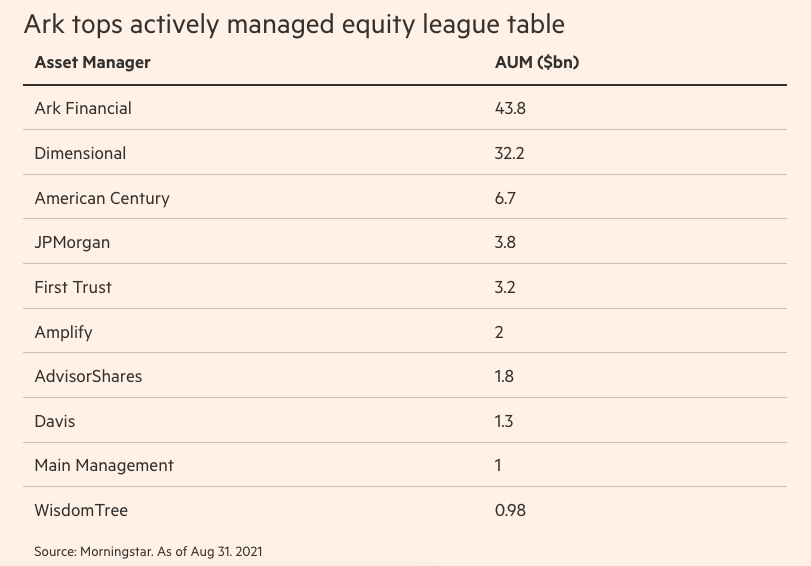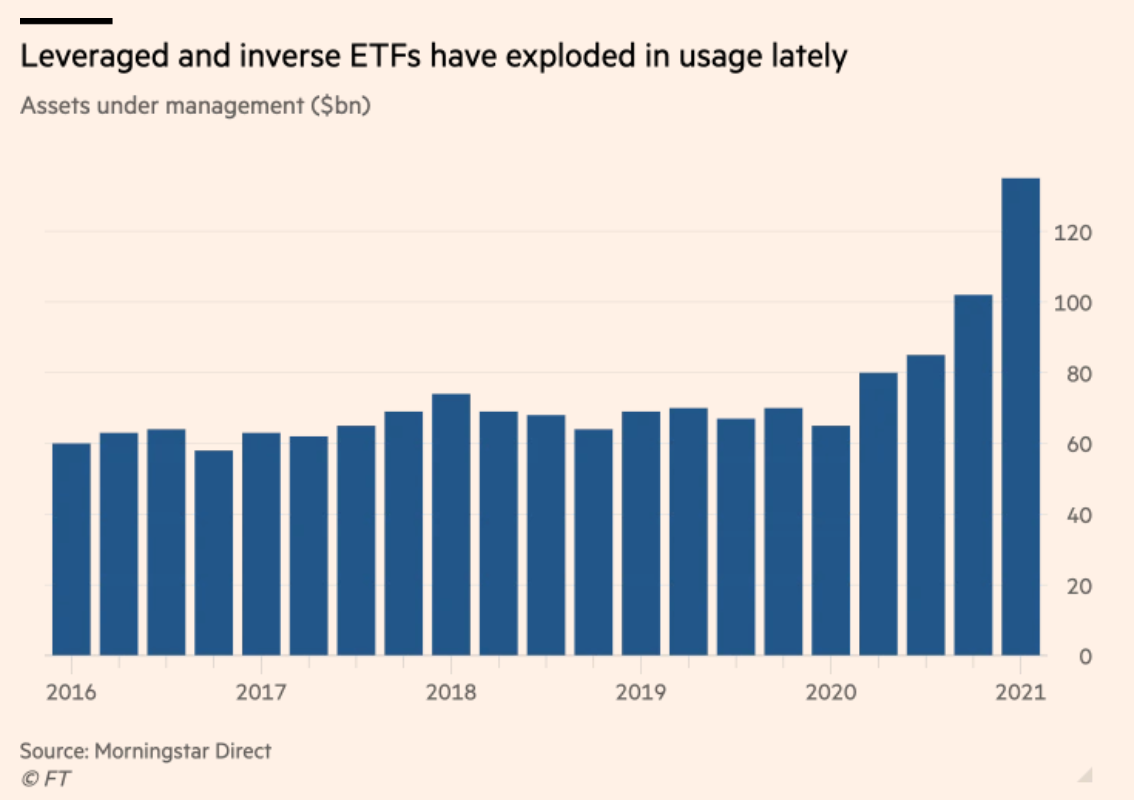The ETF boom is looming.
“Globally, there are more than 70,000 mutual funds with combined assets of almost USD40tn, according to Morningstar. The combined private equity and hedge fund industries can muster maybe a fifth of that. Despite a decade of rampant growth, there is still just USD9tn in 7,000 ETFs globally. Yet the era of the ETF is dawning.”

Source of quote and graph: Financial Times Aug 2021 (paywall)
There has been plenty written about the benefits of ETFs; in particular, the advantages and flexibility of investing with ETFs being analogous to tradeable, Lego-like blocks.
Having observed and participated in this space, the shift to ETF is happening in four concurrent acts.
____________________________________________________________
1. Incumbent mutual funds converting to ETF
“The latest sign came when JP Morgan Asset Management said it would convert four actively managed mutual funds with USD10bn of assets into ETFs. This followed Dimensional Fund Advisors (DFA) earlier this summer turning USD29bn worth of mutual funds into ETFs – this is now the industry’s largest mutual fund-to-ETF conversion. Many more conversions are in the works. Bloomberg Intelligence’s ETF analysts reckon that more than USD1tn of mutual funds could be transformed into ETFs in the coming decade.”
Source: Financial Times Aug 2021 (paywall content)
DFA’s move to ETFs brings one huge benefit to its clients: Reduced fees.

Source: Dimensional Fund Advisors Nov 2020
Following the conversion, the management fees of these six funds are expected to be reduced by 27 percent, on average, from current levels on an asset-weighted.
Now that the incumbents JP Morgan, DFA, and Capital Group have finally made a move, watch as the tectonic shift of legacy mutual funds to ETFs continue to pick up pace.
____________________________________________________________
2. Raise of robos powered by ETF
Robo advisors are digital platforms that provide automated financial planning and was pioneered by U.S.-based Betterment two years after the 2008 global financial crisis. These platforms bring plug-and-play, low-cost investing to the wider public, especially those who are new to investing.
The U.S. has the widest adoption with USD937bn in AUM by the end of 2020 while China is second with USD91bn, according to Statista.
Almost all robo advisors offer a range of plain vanilla, ETF-based portfolios (typically long only) as a core offering. Here’s a sampling of three leading platforms and their ETF fund selection rationale:
- Betterment with USD29bn AUM (What’s inside?);
- Singapore-based StashAway with more than USD1bn AUM (ETF fund selection); and
- Hong Kong-based Aqumon with undisclosed AUM (Why do we choose ETF?)
This empowerment of retail investors will continue and is to be commended.
____________________________________________________________
3. Thematic ETFs because they are easy to understand
Thematic ETFs have gone from making up roughly half of 1 percent of the total ETF industry before the pandemic to about 2.2 percent; and thematic ETFs are typically long-only.
With highly-accessible themes such as Lithium & Battery Technology ETF, Online Retail ETF, Cannabis ETF, and Carbon Credit ETF, these products are effortlessly understood by retail investors and practically sell themselves. (Though a wide selection does not necessarily translate to an easy choice for investors.)
One does not mention thematic ETFs without acknowledging Ark Invest.

With USD43.8bn in AUM, Cathie Wood is the current ambassador for the disruptive technology theme, high levels of transparency, and excellence in social media – Wood’s mainstream and social media presence is a master class in marketing to retail investors. (The excitement and drama around Ark Invest continues to unfold as the ‘Big Short’ investor Michael Burry is betting against Cathie Wood.)
____________________________________________________________
4. Funds applying complex strategies using ETF
If ETFs are Lego-like blocks, think of the fund managers in this fourth category as Lego Master Model Builders. (Yes, that is a real job and an official title.)
There are two defining characteristics for funds in this category: (i) The use of alternative ETF/ETN such as leveraged, inverse, and volatility; and/or (ii) The application of sophisticated trading strategies including short sale, trend following, momentum, and statistical arbitrage.

Source: Financial Times
In general, the investment mandate is for high performance, risk-adjusted returns. Or it could be a niche, tail-end risk mandate – think huge profits but only during a global catastrophe.
Because of the use of alternative ETF/ETN or short sale, such funds are subject to their respective regulatory environments and fund constitutions, and may be restricted to accredited investors only. (As compared to the above three categories of ETF that are for retail investors.)
Alphalytics Quant Multi-Strategy (AQM) is exemplary of a fund in this category. In essence, AQM is no different from a traditional hedge fund that conducts direct buy/sell of securities, apply leverage, uses sophisticated trading approaches or complex futures and derivatives.
The key twist applied by the AQM Lego Master Builder is the use of the ETF.
____________________________________________________________
Conclusion
These four acts — shift from mutual funds to ETF, robo advisors using ETF, popularity of thematic ETF, and complex strategies applying ETF — will continue to hasten the next age of investing in the ETF.
At its core, AQM is a sophisticated investment strategy with an innovative use of the ETF as an adaptable wrapper, which results in significant cost savings (operational and trading) and higher gains for investors.
In sum, AQM is amongst the first wave of funds using ETFs to seek high, risk-adjusted performance. We believe that more funds will catch on to the advantages and flexibility of investing with ETFs; in the meanwhile, AQM investors are already benefiting in this new era.
____________________________________________________________






